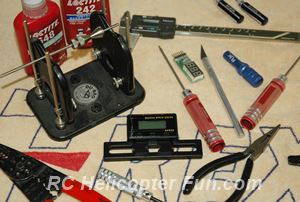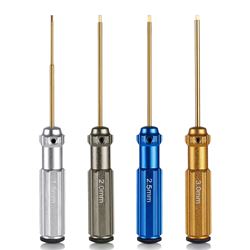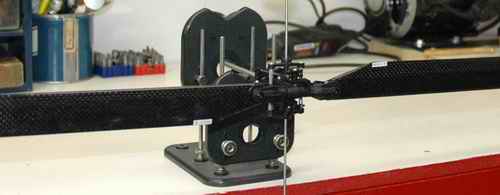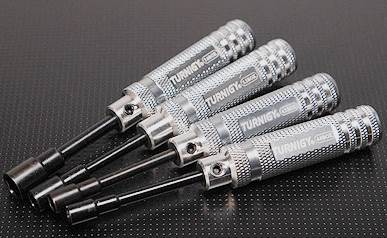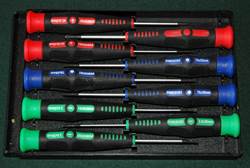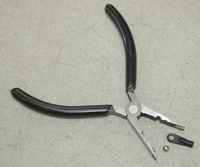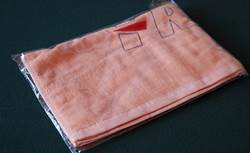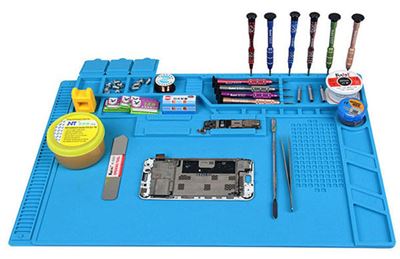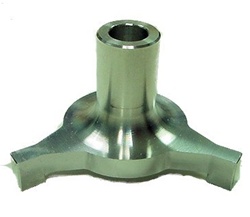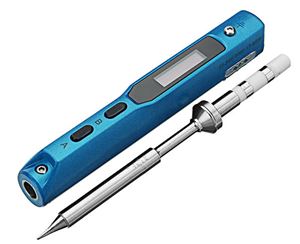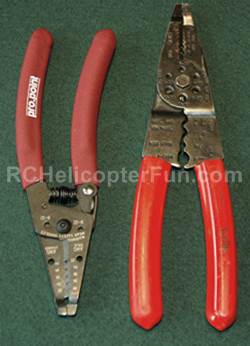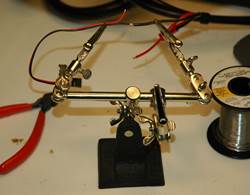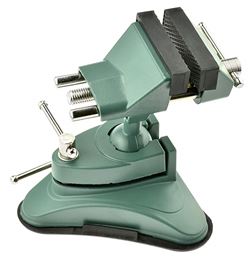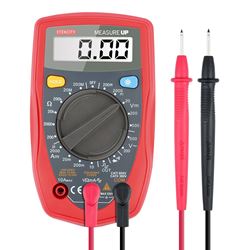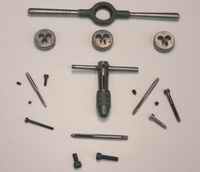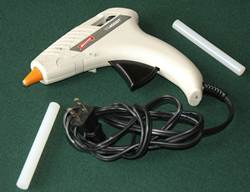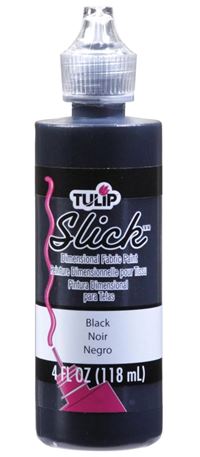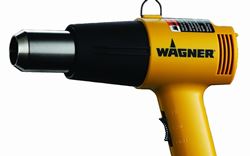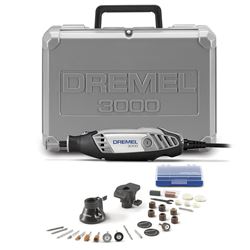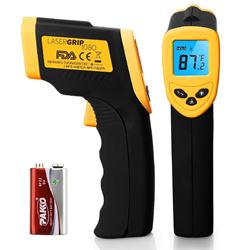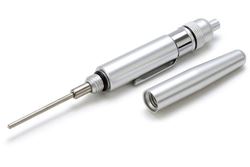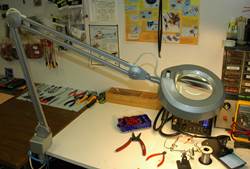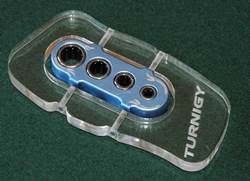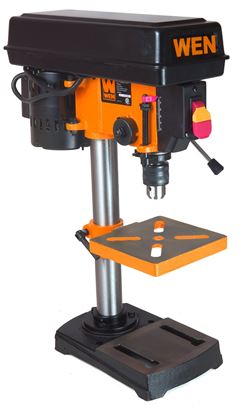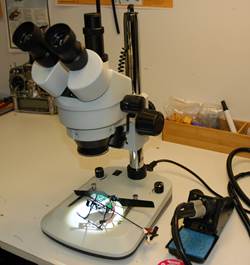Master Class In RC Helicopter Tools
What's On My Work Bench & Why.
by John Salt - Last Updated June 2024
There are a number of RC helicopter tools and supplies that you'll need to build and maintain your RC helicopter/s.
On this page, I'll be showing you what tools I use in the hobby, where & how they are used along with useful "Tool Tips".
We'll start with what I consider to be Must Have Heli Tools and then get into the Nice To Have Heli Tools. You certainly don't need to get every tool shown in other words. As you gain more experience in the hobby, you'll slowly start acquiring the nice to have tools making your time at the workbench more enjoyable, productive and easier.
Collective pitch RC helicopters are mechanically complex after all and wrenching on them is as much a part of this hobby as is flying them. Working on your birds can also be a very enjoyable and fun part of this hobby for many; becoming a tool junkie is often the end result.
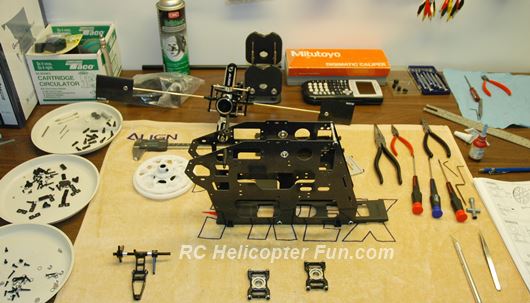 Building an RC heli requires the right RC helicopter tools.
Building an RC heli requires the right RC helicopter tools.Even if you get a ready to fly heli, you will still need some of these tools for future repairs, maintenance and adjustments.
Many of these RC helicopter tools you may already have kicking around in your workshop or tool box, especially if you are already into some type of RC hobby; but there are a few specific RC helicopter tools that you'll probably still need to get, some of which you may not even know exist and what they are used for.
I have provided links to many of these RC helicopter tools so you can further read up on them and get an idea of costs, or need to order a particular tool/s.
Here we go...
Must Get RC Helicopter Tools
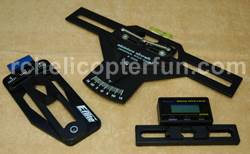
An RC Helicopter Pitch Gauge is essential to correctly set the pitch angle and range of pitch on your main rotor blades on collective pitch RC helicopters.
It's one of the most important RC heli specific tools you absolutely must get if you are getting into collective pitch. You can get basic analog ones, but I personally really like the digital pitch gauges because they are so easy and fast to use, plus they work on 200's all the way up to 800 size helis.
My RC Helicopter Setup & Tips eBook also shows how to make your own simple wedge pitch gauge & how to use it in chapter 3; especially useful on micro collective pitch helicopters that these larger analog & digital ones won't fit.
An assortment of metric Hex/Alan Drivers for the many hex bolts and set screws found on RC helicopters.
Most heli kits don't come with Alan keys anymore and if they do, they are usually poor in quality, made of soft metal and round off or strip out very easy.
This not only makes the tool useless, it also damages the hex set screw or bolt - very frustrating!
The sizes you use most often in this hobby are 1.5, 2.0, 2.5, & 3.0 mm. The best advice here is to start with a decent quality basic set with hardened ends like the Neewer set shown here.
Ball end metric hex drivers can also come in very handy in this hobby. The end of the hex is actually ball shaped; this allows you to come at the hex bolt/screw at a slight angle. On some builds, these balldrivers can be a huge time & frustration saver!
The only drawbacks with the ball ends is they don't "hold" the screw like the normal ones do (not good for set screws). They can also round out the hex head if you over torque them or if the hex bolt or set-screw are seized.
I find I use both the ball and normal hex drivers about equal amounts during a build/maintenance/repairs, but if your budget only allows one type for now, get the normal ones as they will serve you the best.
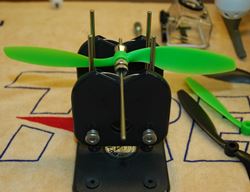
The Dubro Balancer Pictured above & left is an amazing "must have" RC helicopter tool in my opinion.
I have used it for main and tail rotor balancing on all sizes of helis, engine cooling fan / clutch balancing, airplane propeller balancing, RC car and truck wheel balancing, and Multi/Quad rotor propeller balancing.
Hell, I even use it to check the balance of lawnmower blades to a much greater accuracy than most lawnmower blade balancers.
It offers such great value since it can do SO MUCH for about $30 USD.
There are stand alone rotor blade balancers, but you can't check the whole rotor head or use them for all the other aspects of RC balancing that the Dubro provides; not to mention they are not as accurate as the Dubro.
A basic set of metric nut drivers also comes in handy if you don't already have a set of small metric sockets.
The nut sizes most commonly found on RC helicopters (RC in general actually) are 4.0mm, 5.5mm, 7.0mm & 8.0mm.
I'm sure most people already have a basic precision screw driver set such as shown here but I figured I better mention it.
On RC helicopters, you mostly find Phillips Heads, but you may come across flat head, and rarely Torx.
One thing I recommend is to stay away from screw driver sets (and hex driver sets) that come with one single handle along with a number of slide in bit ends. They work fine & if budget is tight are worth consideration, but they are a real pain to use when you have to stop and change a bit end every time you run across a different screw or hex head (which is often in this hobby).
Ball Link Pliers - Okay I admit I got by for years without this tool. I used needle nose pliers instead.
I damaged many ball links and balls, I spent more money on replacing them than the pliers cost, not to mention the frustration - don't make the same mistake I did.
There are even ones for micro helis these days.
Assembly/Repair Towels for how little they cost (or are even included in some kits) are wonderful things to have.
They are not really a tool; but once you've built or worked on a heli with an assembly towel underneath to catch screws, bolts, washers, setscrews, or any other little items that otherwise bounce and roll off the bench or table into the dark abyss below; you'll never want to be without one again.
Another option is a silicone hobby mat.
The nice thing with these things is you can get solder, glue or paint on them and it's easy to remove.
They just wipe clean when you get grease, oil, or Loctite on them as well. Some even have nice little recessed pockets along the edges for screws and such.
Regardless which working mat type you choose, best to choose a lighter color one. Most RC helicopter screws and set screws are case hardened, and dark in color which makes them difficult to see against a dark/black working surface.
Swashplate Leveling Tools - These tools are very important for setting up a 120 degree CCPM swashplate correctly and leveling it.
This is even more important these days with flybarless systems as the swash has to be more or less perfectly level when you register that neutral position in the FBL unit.
I have an eBook on Swash Setup that shows how to build your own swash tool as well, but these purpose designed tools work the best, are the easiest to use, and are the most accurate. They come in all sizes for different rotors shaft diameters so it's important you know your shaft size so you get the right size leveling tool.
If you happen to have or know someone with a 3D printer, you can also find swash leveling tool print files on 3D file sharing sites like Thingiverse. I've printed a few out to test them and while not as accurate as a machined metal one, they work pretty well; certainly better than eyeballing the swashplate level.
Glow Plug Wrench (long reach is nice on RC helicopters) - Only needed for nitro powered birds.
Nitro RC glow plugs require a 5/16" socket, so really any long or 5/16" socket with an extension can be used. If you already have a 1/4" socket set, chances are you have a 5/16" socket that will work.
To save on page download time, the rest of the must have RC helicopter tools & consumables listed don't show photos since I'm sure you know what they look like and likely have most of them.
- Precision Pliers Set
- Small Vice-Grip Pliers Set (needle nose & regular)
- Basic Tweezers Set
- Hobby knife and blades
- Metric ruler
- Goes without saying - A Work Bench/Desk/Table
- Electric Drill - a variable speed cordless is nice
- Quality HSS Drill Bit Set
- Blue medium strength Loctite or similar thread locker
- Brake Cleaner / similar solvent to clean greasy fasteners & parts.
- Epoxy glue - 5-minute is good for most applications
- Instant CA glue - I find I use thin & medium thickness the most along with a CA accelerator. I like Mercury Adhesives CA glue the best after trying many brands over the years - great no clog tips/caps.
- Various bearing grease and light lubricating oil - your kit may come with these.
- Heat shrink tubing
- Electrical tape
- 3M Double Sided Tape
- Nylon Zip Ties (assorted sizes and lengths)
- Shop Towels
Nice To Have RC Helicopter Tools
Okay, now we get into the stuff you might not need in order to build and maintain your RC helicopter/s, but most of this stuff will make your life easier once you get it; or you may find you do actually really need it as you advance in the hobby.
I've listed more or less in order of importance. The first few top items will be consider "must haves" by some RC modelers, so there is a bit of gray overlap area here between must & nice to have depending on the person and what they fly.
RC Soldering Tools!
These are considered a must have if you are into electric RC flight, or any other electric RC discipline for that matter.
Soldering is a big and important enough topic that it deserves it's own page.
On that page, I cover all sorts of RC soldering topics from the most common beginner soldering questions I get, right up to equipment and solder recommendations best suited for the hobby.
This video I made may also answer a few beginner soldering questions.
If you're going to be soldering wires, you are going to need a way to remove the insulation off the tips of the wiring - enter the indispensable wire strippers.
There are various types of wire strippers from the "one size fit's all" types to the more common types that accommodate each individual gauge size such as pictured here.
I like this style the best myself for the simple reasons I find them more precise in that they are less likely to tear the wire insulation and they are less likely to tear/cut the wire strands in stranded wire. They even double as a nice pair of pliers.
No matter what type you choose, you need to get strippers that cover all the sizes of wire you end up working with. For electrical RC usage, that can be anything from as small as 30 gauge that you see on some tiny servo leads or scale lighting systems, right up to 8 gauge on large electric motors, ESC's, and LiPo packs.
I need two sets of strippers to cover that range. The smaller set covers 30 up to 20 gauge, and the larger set covers 20 up to 8 gauge.
When soldering, I really find these "Third Hand" doo-dads (also called "helping hands") indispensable.
You generally need both your hands while soldering; one to hold the iron or gun, the other to feed the solder. Using a third hand device to hold the actual wires, plugs, LED's, circuit board, whatever in position while soldering makes life much easier; also making cold solder/brittle solder joints much less likely.
A small hobby vice is a useful tool. I use mine in the hobby primarily to hold RC battery connectors securely while soldering them, but they come in handy for many other things too.
There are many different kinds such as clamp mount that will clamp to a desk edge. Or ones with suction cups on the bottom that will stick to the bench/table top.
Fastener mount vices are the other option that you bolt down to your workbench/table top - very sturdy for heavy holding.
Digital Calipers or just regular calipers is another tool I feel is almost a must have in this hobby.
I use mine all the time for measuring pushrod lengths, shaft diameters, bearing sizes, screw lengths, drill bit diameters, pitch slider centering on the tail shaft, spacer washer thickness, clutch liner thickness, swash height, servo wheel hole distances, carbon fiber plate thickness just to name a few of the uses off the top of my head.
I'm sure I could come up with at least another dozen or so just related to RC helicopters, and a magnitude more for all the other things I use them for around the shop & house.
If you are into electric flight, a basic DMM (Digital Multi Meter) is a handy RC Helicopter tool to have allowing you to measure battery voltages, small current loads, and diagnose opens and shorts in wiring harnesses or circuits. You can certainly spend hundreds of dollars on good DMM's like a Fluke 87V; but you don't need anything that high quality for simple RC voltage & diagnostic work.
Below is a video I made going over some of the basics of what I personally look for in a multi meter. It's an overview I did on the Fluke 17B+. Overkill meter for the average RC hobbyist, but at 1/4 the cost of the Fluke the 87V, with many of the same functions, it's a decent value for a very good quality & safe meter.
Another really good "RC hobbyist" DMM on the market in my opinion is the Fluke 101. It's small, it's got the important features you'll need for RC usage along with Fluke's legendary safety, quality & robustness for around $60 USD.
Metric tap-and-die set or at least 3 of the most commonly used sizes such as M3-0.5, M4-0.7, and M5-0.8.
I personally feel this could almost be considered a must have tool.
Again this is a tool that
pays for itself over time. I show just how handy these tools can be in my Setup & Tips eBook.
As I mentioned, you can order separate size tap's (which you will use more than die's), so don't think you have to spend a small fortune on a full set. That said, full sets are fairly good value, but much of what the full sets come with you may never use (at least for RC). If budget is really tight, pick up a small metric M3 To M8 Tap set with T-handle. Then you can build your own customized sized set as time goes by.
You likely already have a hot melt glue gun lying around; but if not, they are good RC helicopter tools and come in handy for our hobby.
I have used mine for tacking down wiring on board the aircraft, while making my own LiPo battery packs to insulate and secure the main & balance wiring on the connection tabs, making temporary repairs to micro RC helicopters, tacking high stress plug locations so the plug doesn't wiggle loose, insulating/sealing custom built wiring harnesses, insulating/sealing exposed circuit boards, mounting some electronic control modules on-board the aircraft, etc.
The great thing with hot melt glue is it sticks well to most things, yet can be fairly easily cut away if you need to remove it or heated back up to soften it. It's also a fast curing glue method. The one thing to be careful with however is the stringy spider web (what I call them) trailers that pull away from the glue gun. These fine glue stringers can and will get tangled in rotating components such as gears and around motor shafts if you don't remove them after your glue job.
I personally like the full size glue guns because they use the regular size glue sticks which are much easier to find and represent better value.
While I'm on the topic of gluing/tacking things, I may as well mention another useful "tacking" consumable I use in the RC hobby and other electronic projects - Dimensional 3D Fabric Paint.
This stuff works great for making wire strain reliefs or tacking the exterior of servo connectors to the receiver or flybarless system so they don't vibrate loose (run a small bead along the exterior where the connectors are inserted). I also use it inside A/B clips on LiPo balance leads and for antenna strain relief.
I'm sure you've run across/seen similar electronic grade silicone blobs on various electronic components but electronic grade silicone/RTV is hard to source and costly.
3D fabric paint is easy to find, inexpensive, electronic safe and comes in many colors including bright florescent if you want a high visibility tacking substance. It can be cut/peeled away when you want to remove it easily enough (just like electronic grade silicone) and is similar to plasti-dip in viscosity, but easy to control when applying to small components.
A heat gun is great for shrinking heat shrink tube, softening/melting the aforementioned hot glue to reposition things and to heat up metal parts to aid in removing pressed in bearings, soften bearing retaining compound and thread locker.
I've also used my heat gun to heat up fiberglass canopies and fuselages to reshape them if/when they warp or are packaged badly and are misshapen. You don't hold the heat on for long or you risk bubbling the paint; just long enough to soften the fiberglass resin. Hold the canopy or fuselage in the correct shape and as the fiberglass/resin cools, it will take on the new profile.
There are also mini-heat guns and if you are only going to be using a heat gun for RC/hobby type work, the mini type are an economical option that work well.
Dremel or similar moto-tool with accessories. Not much to say here... After you have and use one, you won’t know how you lived without it.
Grinding, cutting, shaping, sharpening, sanding, drilling, cleaning & polishing. I use my Dremel almost daily!
For scale RC helis it's an absolute must have! I could not build a scale heli without this tool.
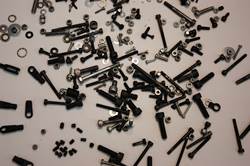
An assortment of metric screws, set screws, nuts, washers, ball links and balls. These little guys seem to always fall off the work bench into another dimension, get striped out, wear out, or just need to be replaced from time to time – spares come in very handy.
These handy Infrared Thermometers are useful for much more than RC as I'm sure many of you know and very likely already have one in the old tool box - especially now that they are so inexpensive.
Great for checking the temperature of your LiPo packs, motors, ESC's, servo cases, engine head temps, etc.
I payed over $100 for my Raytek one several years ago, and I honestly don't find it any better or more accurate than these new ones you can pick up for under $30 bucks!
I find these pen sized Precision Oilers very handy.
I mention just how well they work in my Setup & Tips eBook in the lubrication section. Beside the precise and mess free application, you can fill them with your particular favorite liquid lubrication for any application and they don't leak.
Ball End Drivers (also called ball link wrenches) really save the old finger and thumb when you are threading ball links onto the ends of all the pushrods on an RC helicopter build.
Once you get a pair of ball end driver RC helicopter tools; you, or more precisely, your forefinger and thumb won't dread threading all those links.
Before I got these RC helicopter tools, I used to use a small crescent wrench. It worked but not as fast or as easy. Still, it's a good option to use when your thumb & finger can't take the pain of threading one more single ball link.
I really enjoy my desk mount magnifying work lamp in this hobby.
Kinda could not live without it lately as the 50+ year old eyeballs have an increasingly hard time seeing small stuff up close.
It serves a double duty workload proving both light if you only want to use it for that, and/or magnification.
I can move it up high overhead the bench to provide a nice amount of direct down lighting (or any angle I choose); or I can move it close in, using the large magnifying window to see those tiny parts better while soldering or assembling.
A head axle / feathering shaft wrench is a great RC helicopter tool to have when one of the blade grip hex bolts is stuck in the head axle shaft.
I used to wrap the axle with a few winds of electrical tape and then grip it with vice grips which works fine; but using this tool with the one way bearing to grip the axle is faster and safer for the axle.
This particular one fits 5mm, 6mm, 8mm, & 10mm axle/feathering shafts so it's for larger helicopters.
 RC Helicopter Optical Tachometer
RC Helicopter Optical TachometerAn optical RC Helicopter Tachometer is something used to confirm how fast your rotor is spinning while flying.
You have a spotter look through it (why it's called an optical tach), at a safe distance away from the heli while you are hovering or flying. The spotter will dial the flash rate of the viewing window up or down.
When the flash rate matches the rotor RPM, the blades will look they are not spinning and the RPM for that specific flash rate will be shown on the display.
When you are first starting out, you certainly don't need one, but it's something that you eventually may want to invest in.
Likewise, if your ESC has an RPM data log feature, or you use a governor or you monitor RPM telemetry, you also don't need one.
I really liked this style I have pictured because the optical shutter window is nice and big and it covers a wide range of RPM's (800 - 4200).
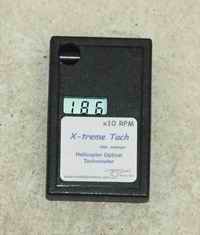 My Old Optical Heli Tach that I've had for many years.
My Old Optical Heli Tach that I've had for many years.Way better than the mechanical rotating shutter type I have with the tiny window - cheaper too!
Regardless of style, all these optical tachs are getting very hard to find, so if you have one, hang on to it.
The other tach option is a non-contact digital laser tachometer. These things have impressive RPM measurement ranges, are easy to use, accurate and inexpensive.
The drawback with them is you have to be close to the spinning rotor/object so they are no good for larger helicopters due to the danger involved. They work fin on micros however. Here's a review on the Uni-T UT373 laser tach I use with a couple micro heli RPM readings.
Here's an RC helicopter tool I really enjoy.
A Crimp Tool specifically for RC servo and other small plug connectors. If you want to save a good deal of money by making your own custom servo wiring harnesses or other harnesses that need to have the pins in the plugs crimped onto the small wires.
These tools pay for themselves quickly not to mention make a tedious job go quickly. It's another one of those tools that I got along without for years but after getting one, would find very hard to be without.
8" bench sized drill press and drill press vice.
A much more accurate way to
drill holes in everything from servo wheels to engine mounts. If you are
into RC fabrication of any sort, you'll find a drill press indispensable.
Here I'm using one to drill a broken bolt out of a rotor head. Very doubtful I could have done it free hand...
Stereo microscopes such as the Amscope SM series 7-45X zoom stereo microscope seen here are one of those tools you never even considered important, that is until you get one.
I find this scope almost as useful as my magnifying lamp. A stereo microscope is pretty much an essential tool if you are doing any amount of SMD electronics soldering/rework or even small parts inspection.
Close up inspection of small micro helis like I have on the stage in this particular photo, is an easy task with a scope like this. The micro servos to the SMD circuit board components are easy to see and even repair if you are so inclined.
Another really popular great value Amscope stereo microscope for basic electronics work & small component inspection is their SE-400 series. After using a zoom stereo microscope in my lab days however, I figured getting the zoom feature over two fixed powered objectives was money well spent. Hard to believe quality scopes like this are now so reasonably priced that even hobbyists can now have them on our work bench.
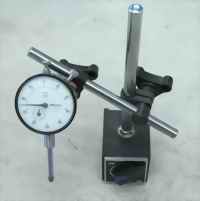 Dial Indicator with Magnetic Base
Dial Indicator with Magnetic BaseDial indicator with a magnetic or clamp base is almost essential for fuel powered helis to ensure the fan hub has next to zero runout when mounting it on the engine output shaft.
Great for planes as well to see if the motor/engine shaft is bent even the slightest amount after a crash. A dial indicator with 0.001" resolution is adequate I find.
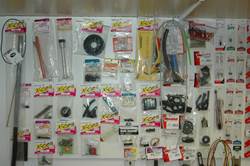
Okay, they are not exactly RC helicopter tools; but having replacement RC Helicopter parts on hand for repairs is very convenient when you don't live near a good hobby shop.
This is something that just comes with time and experience of what wears out or breaks often on your specific birds.
After a while, you'll know what parts to stock but as I've said many times; no matter how well stocked you are, Murphy's Law often prevails and you'll still need a little part you never even considered.
In short, don't sweat it and don't try to get every part going. I've actually run into the situation where I have so many parts on hand, I sometime don't realize I have the part I'm looking for and still end up ordering it when it's staring me in the face - DUMB!
Considering that last point... A small parts bin organizer to keep all your heli bits organized and easy to find.
Small hobby air compressor with air brush kit . These are not only handy for your prize winning custom paint job, but can also be used for general air/blow dusting and drying of small parts by simply putting an air nozzle on the end of the hose.
3D Printer - this is my latest tool acquisition, and I've already found it useful for many RC heli related projects (plus many others).
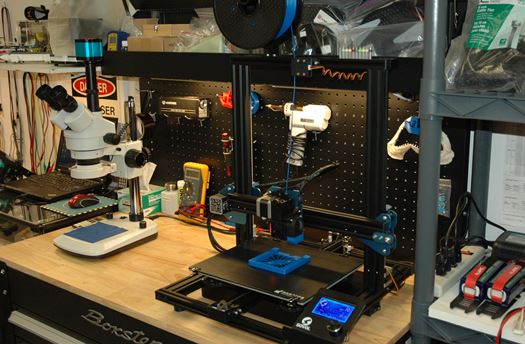 My 3D Printer Work Station.
My 3D Printer Work Station.3D printing complements the RC hobby so well. Most RC helicopter hobbyists I've talked to over the past few years who got into 3D printing actually found it fairly easy because so many skills & knowledge are transferable between the two hobbies. I found this to be the case as well.
Prices for decent hobby grade FDM (fused deposition modeling) 3D printers have also dropped substantially over the past several years, and you can get very good quality and fairly large build volume 3D printers now in the $200 to $300 price range.
There are so many good hobby grade 3D printers on the market these days so I can't recommend which is best for your needs. As shown in the above photo of my 3D printer, after several months of research, I decided on the Sovol brand which I'm so happy with; but again, do your own research.
Getting into 3D printing is very much like getting into RC helicopters. Lots to learn, a never ending learning curve, and so bloody fun & engaging.
Small Hobby Ultrasonic Parts Cleaners are great for cleaning small parts; but I had gotten by without one for years and honestly don't use it much. My wife has basically taken it over for washing her rings and earnings in which it does a great job at I might add.
I do however use my larger bench size solvent parts cleaner a fair amount. Much more often for fuel powered RC stuff, bike parts, and just about every other greasy part in the garage. You don't really need one for RC, but I had to mention it because I do use it for RC heli service from time to time.
If you don't like messy hands - nitrile surgical gloves.
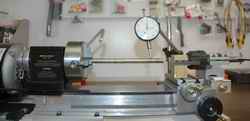
Mini Hobby Lathe - since I got a Taig Mini Lathe, I've machined my own custom parts for my RC helis (and many other things).
The main thing I find I use the lathe for with RC helicopters is checking shafts (main, tail, blade grips, engine, fan hubs, clutches, clutch bells – you name it) for run out with a dial indicator. No more guessing what shaft might be bent after a crash.
If the bend is not bad, I have even been able to
straighten some shafts to within ½ thou of an inch run-out. Machining clutch bell liners is also another very useful task I have used mine for.
I most certainly don't recommend investing in one of these for RC use alone; you better have other uses for it as well. Working with a machining lathe is also a hobby in and of itself. They are as much fun as the RC heli hobby if you are into this kind of stuff.
Make Your Own RC Helicopter Tools
I've also had to make my own special RC helicopter tools on occasion. Here's one such example in this swashplate service video I did (tool makes its appearance at 4:43 into the video).
Well, hopefully this helps you navigate your way around the "RC Helicopter Tool Topic." Just like I mentioned on the RC Field Box page, over time you'll probably find a few other tools and supplies that come in handy or need for your specific helicopter/s.
If there is a useful RC helicopter tool you use that I have not listed here, by all means please contact me to let me know about it. It doesn't take much arm twisting for me to justify adding another tool to the old RC helicopter tool box after all!
Yes, I'm an RC Helicopter Tool Junkie ;-)
Bringing All Your RC Helicopter Tools Together
Perhaps the most rewarding aspect while getting all your RC helicopter tools, is creating your RC work space to use them in. Again, I fall into the "tinkering" category in this hobby and can lose myself for hours in my little RC workshop here, working away on my birds and other interesting projects. Just a really fun place to be and unwind :)
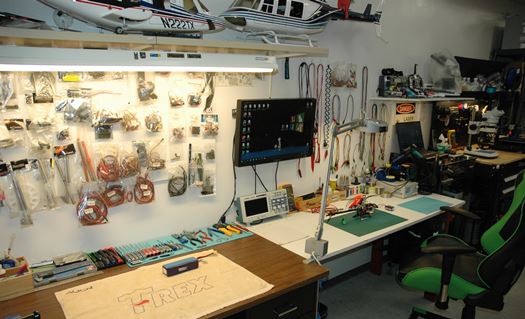 My RC Helicopter Workshop
My RC Helicopter WorkshopMany of the RC helicopter tools that were listed on this page can be seen in the above photo. The other thing you may notice is I have 3 distinct work/bench areas that I tend to use for different parts of RC helicopter building and maintenance. Depending on what primary task I perform in each area, will determine which RC helicopter tools I chose to keep in that specific area.
Closest (left side) is my primary building / mechanical service area. Next to it (the middle section) is my electronics work area & component programming / firmware updates (ESC's, FBL, radio, etc). This is also where I film many of my YouTube videos. Beside it is my main RC parts storage cabinet and laptop, and beside that on the far right, my inspection microscope & 3D printer bench.
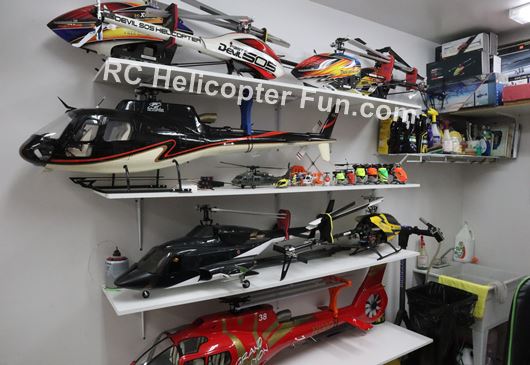 I keep my most used helicopters on these easy to reach shelves.
I keep my most used helicopters on these easy to reach shelves.On the other side of this area is a utility sink and shelving for some of my RC helicopters.
Visitor's RC Heli Workshop
A customer sent me this photo of his recently built RC heli workshop - clean, bright, and organized! I thought it was a great image of a great RC heli work space... Thanks for sharing Steve :-)
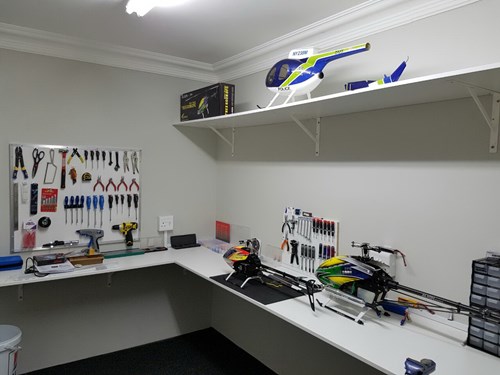 Steve's Heli Work Shop
Steve's Heli Work ShopHi John
I made contact with you last month about how great your site is and I use it daily. I have taken your advice on tools needed and have attached a few pics of my Heli workshop.
Thanks again for the great site.
Regards
Steve - South Africa
